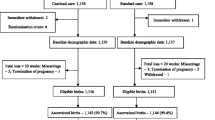Abstract
Objective: To assess length of stay, home visits, and mothers' feelings after full implementation of a law requiring a 48-hour minimum stay for women with normal vaginal deliveries. Methods: The New Jersey Electronic Birth Certificate System (EBC) was used to capture demographic characteristics, and length of stay (LOS), and to select a sample of women with low risk uncomplicated vaginal deliveries. A follow-up mail survey (with a nonresponder phone component) enhanced the information available on the EBC. Results: The response rate for women included in the sample was 82.1% (1276/1555). The mean length of stay was 1.9 days. Sixty-two percent (787) of women thought their LOS after delivery was just right. Women who thought their stays were too short tended to be older, married, working outside the home, or have an LOS of less than 48 hours. The most common reasons for thinking the LOS was too short was a need for rest and concern about the baby. Discussion: The combination of an augmented electronic birth certificate system and a follow-up survey proved to be a rapid, reliable, and inexpensive method of assessment. The mothers' desires for rest, education on the care of her newborn, and reassurance that any medical complications could be handled, are paramount concerns that need to be taken into account by payers and practitioners wanting to decrease LOS.
Similar content being viewed by others
REFERENCES
Newborns' and Mothers' Health Protection Act of 1996. Public Law 104–204, September 26, 1996, enacted as Title VI of the Departments of Veterans Affairs and Housing and Uban Development and Independent Agencies Appropriations Act, 1997.
NJ Stat. Ann. 17:48–61 as amended by Public Law 1995, c. 138.
Reinhardt EE. Commentary: Efficiency and civility in maternity care or “how much Jello can a mother eat?” Med Car Res Rev 1999;56(1):47–54.
Charles S, Prystowsky P. Early discharge, in the end: Maternal abuse, child neglect, and physician harassment. Pediatrics. 1995;96:746–7.
Tai-Seale M, Rodwin M, Wedig G. Drive-through delivery: Where are the “savings”? Med Care Res Rev 1999;56(1):30–6.
The Electronic Birth Certificate Live Birth Registration System **New Jersey** [Computer Program]. Version 4, Lewistown, PA: Genesis System Corporation.
Lasker R, and the Committee on Medicine and Public Health. Medicine & public health: The power of collaboration. New York: New York Academy of Medicine, 1997:95–6.
Kiely M, Drum M, Kessel W. Early discharge, risks, benefits, and who decides, current controversies in prenatal care III. Clin Perinatol 1998;25(3):539–53.
CDC. Trends in length of stay for hospital deliveries—United States, 1970–1992. MMWR 1995;44:335–7.
CDC. Average postpartum length of stay for uncomplicated deliveries—New Jersey, 1995. MMWR 1996;45:700–4.
PRAMS questionnaire accessed 8/19/2000 at: http://www.cdc.gov/nccdphp/drh/questionnaire.htm.
Dillman D. Mail and telephone surveys—The total design method.Wiley: New York, 1978.
Dean AG, Dean JA, Coulombier D, et al. Epi Info, Version 6: A word processing, database, and statistics program for epidemiology on microcomputers. Centers for Disease Control and Prevention: Atlanta, 1994.
Gazamararian JA, Solomon BS. Receipt of home health care after early discharge: Results from a national managed care organization. Maternal and Child Health Journal, 1997;1(3): 151–6.
Young KT, Davis K, Schoen C. The Commonwealth Fund Survey of parents with yourng children. New York: Commonwealth Fund, 1996. Accessed 8/19/2000 at: http://npin.org/library/1998/n00032/n00032.html.
Author information
Authors and Affiliations
Rights and permissions
About this article
Cite this article
Dato, V.M., Saraiya, M. & Ziskin, L. Use of a Comprehensive State Birth Data System to Assess Mother's Satisfaction with Length of Stay. Matern Child Health J 4, 223–231 (2000). https://doi.org/10.1023/A:1026691504548
Issue Date:
DOI: https://doi.org/10.1023/A:1026691504548




